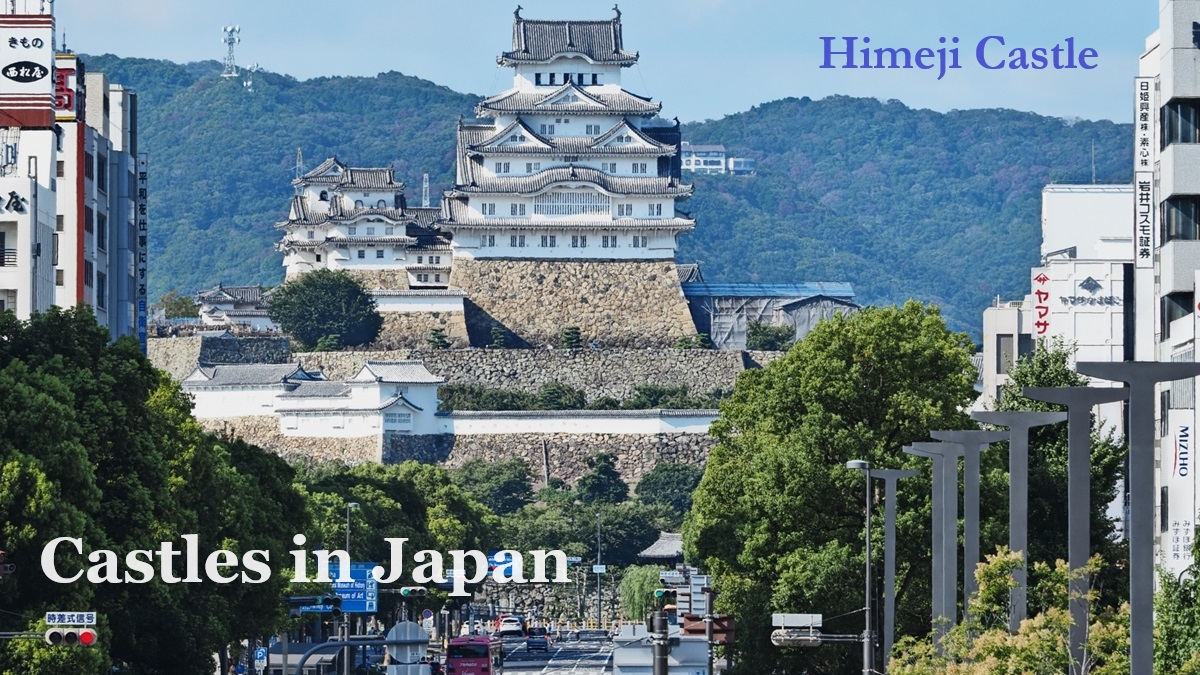Castles in Japan
Japanese castles were originally military forts to battle for expanding the territory of local lord.
The castles were constructed in the 14th to 16th centuries.
It is said that the number is over 40,000 throughout Japan.
After long civil war period, Japan was unified as a nation and Edo (current Tokyo) Government was founded in 1603.
Since that, the main castles were changed to the governing base of each local area.
And many other forts were abandoned.
It is said that the number of remaining castles is 150 to 200.
The symbolic building of Japanese castle is Castle Tower.
It is the central building of the fortress, but it rather showed the power of the lord.
The castle site is mostly surrounded with earthen walls and stone walls, and some observation towers are set up on the walls.
And most castles have moats not to let the enemy get close.
The lord of the castle lived in a palace in the castle site and managed the governmental affairs there.
The samurai retainers of the lord were lived near the castle.
And merchants and common people gathered around the castle, so a castle town was formed.
That is how most main cities in Japan developed.
After the end of the feudal period by samurai, new modern government had demolished most castle towers and the additional buildings as unnecessary facilities in the 1870s.
Many of them became ruins that stone walls and moats remain.
Some castles were preserved luckily, but some of them were destroyed by air raids in the World War II, unfortunately.
Now only in 12 castles, the original castle towers are preserved.
And, some cities reconstructed the former castle tower as the symbol of the city since the 20th century.
In many castles, visitors are allowed to enter the castle tower as a tourist spot or a museum.
Castles in each region
Hokkaido Tohoku Kanto Koshin-etsu Hokuriku Tokai Kansai Chugoku Shikoku Kyushu
Hokkaido Region
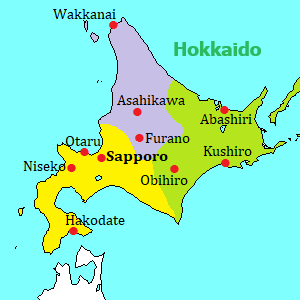
Hokkaido had been an uncolonized land until the 19th century.
So, only one castle had been constructed as the base to trade with Ainu, the indigenous people.
Matsumae Castle (松前城) is a small castle in Matsumae town at the southern tip of Hokkaido.
It is the only castle in Hokkaido and was completed in 1606.
The original castle was burnt down in 1949, then current castle was rebuilt in 1961.
Goryokaku (五稜郭) in Hakodate city was completed in 1866, and it is a unique star-shaped fort surrounded by moats.
A government office was set up, but Edo Government had been overthrown 2 years late.
So this site was open to the public as a park in 1914.
Tohoku Region
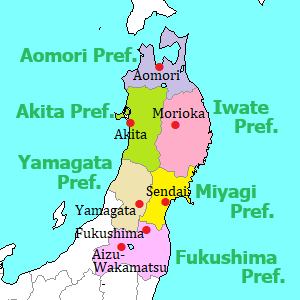
Tohoku Region is far from the capital Edo (Tokyo) and the castle construction technology may have been not so high in those days.
So, the perfect castles with castle tower and stone walls are not many.
Hirosaki Castle (弘前城, Aomori Pref.) is in Hirosaki city and cherry blossoms in spring are very famous.
It was built in 1611, but the castle tower was burnt down in 1627.
The castle tower was rebuilt in 1811, at last, and it exists now.
Shiroishi Castle (白石城, Miyagi Pref.) is in Shiroishi city to the south of Sendai city.
The original castle was built in 1591 and was broke down in 1875.
Current castle tower was restored in 1995.
Shirakawa Komine Castle (白河小峰城, Fukushima Pref.) is a castle in Shirakawa city.
It is said that the original castle was built as a fort in 1340, and the former castle was destroyed by civil war in 1868.
Current castle tower was built in 1991 and the main gate was built in 1994.
Tsurugajo castle (鶴ヶ城, Fukushima Pref.) is in Aizu-Wakamatsu city and it is a symbol of the city.
Original castle was built in 1384, and current castle tower was restored as a museum in 1965.
The red roof tiles are characteristic.
Kanto Region
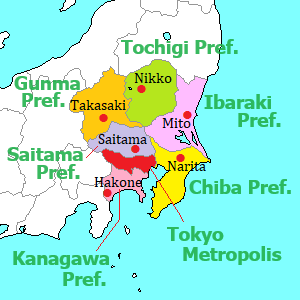
Tokyo is the capital of Japan, and the city name until 1868 was "Edo".
Edo became the capital of united Japan in 1603, and Edo Castle became the center of government.
Edo Castle had been built in 1457, but it was expanded on a large scale for the government.
It became the biggest castle in Japan and gorgeous castle tower was built.
But, the castle tower was burned down in 1658, and it was not rebuilt.
From 1868, the site of Edo Castle became "Imperial Palace" (皇居, Kokyo), the residence of the Emperor family.
Now, Kokyo occupies the wide part of central Tokyo and it is inside of the moats.
Because great Edo Castle was in Edo, almost all castles in Kanto Region had been demolished.
Odawara Castle (小田原城, Kanagawa Pref.) is in Odawara city about 70 km southwest of Edo (Tokyo).
The location is just at the entrance to Kanto Region, so this castle remained and was used as a key strategic point to defence the capital.
Koshin-etsu Region
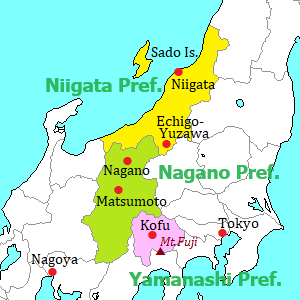
Koshin-etsu Region is the center of Honshu Island and mountainous areas extend.
Some strong local warlords battled to expand own territory in this region in the 16th century.
So many small castles as fort had been built in whole area.
Most of them are ruins, but the major spots are the followings.
Matsumoto Castle (松本城, Nagano Pref.) is one of the beautiful castles in Japan, and the black walls are impressive.
It has an original castle built in 1504 and is designated National Treasure.
The five‐storied castle tower is beautiful.
Kaikoen (懐古園, Nagano Pref.) is the ruin of Komoro Castle built in 1487 in Komoro city, and a few gates remain.
It is said that the castle was an impregnable fortress because of natural barrier by steep cliff.
Hokuriku Region
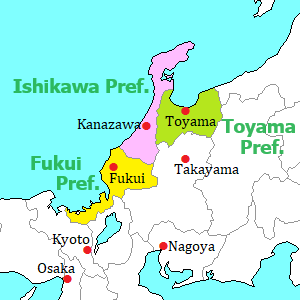
In Hokuriku Region, each local area had been governed by its warlord family.
Especially, Kanazawa became a big castle city.
Castles in this region are not so many.
Various ingenuity is exercised to the roofs and walls of the castle because of deep snow in winter.
Toyama Castle (富山城, Toyama Pref.) was built in 1543.
Some buildings were built, but the castle tower was not built at that time.
The castle tower was built for museum as a simulated castle in 1954.
Kanazawa Castle (金沢城, Ishikawa Pref.) in Kanazawa city was built in 1580.
In the 17th century, Kanazawa became one of the largest cities in Japan, so this castle is large.
Because most buildings were destroyed by fire in 1881, the site became the ruin.
But, many buildings has been rebuilt since 2001.
Maruoka Castle (丸岡城, Fukui Pref.) is in Sakai city to the north of Fukui city.
It was built in 1576, and is one of original 12 casles in Japan.
It is a lucky castle because Maruoka town at that time had bought it when the government demolished unnecessary castles in 1871.
Echizen-Ono Castle (越前大野城, Fukui Pref.) is in a small basin surrounded by mountains and the castle is on a small hill.
The castle was built in 1575 and was destroyed by fire in 1759, and it was rebuilt as a museum in 1968.
Fog enveloped the basin sometimes in cool season and the castle appeared on the sea of fog, so it is known as "Castle in the Sky".
Tokai Region
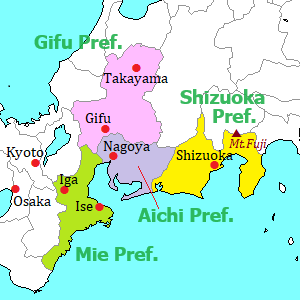
Tokai Region produced three historical warlord heroes:
Oda Nobunaga (1534-1582), Toyotomi Hideyoshi (1537-1598), Tokugawa Ieyasu (1543-1616)
They were the local warlords in this region, but they were strong and capable samurais.
They were mutually rivals, but they waged battles in strategic cooperation.
At last Ieyasu completed the unification of Japan and established Edo Government in 1603.
In Tokai Region, historic battlefields are dotted and there are many castles by them.
Sunpu Castle (駿府城, Shizuoka Pref.) was built by Tokugawa Ieyasu in 1585, and is in Shizuoka city.
Shizuoka was the territory which Ieyasu seized and the castle was his important base fort.
Some historic buidings except the castle tower has been restored since 1989.
Kakegawa Castle (掛川城, Shizuoka Pref.) is a small castle built in the early 16th century in Kakegawa city, and it was one of the castles on the important place in the battles by warlords.
The castle tower was rebuilt in 1994.
Okazaki Castle (岡崎城, Aichi Pref.) is the castle built in 1452 and Tokugawa Ieyasu was born in this castle in 1542.
Former castle tower was built in 1617, after Ieyasu became Shogun.
Current castle tower was rebuilt in 1959.
Nagoya Castle (名古屋城, Aichi Pref.) is a popular great castle built by Tokugawa Ieyasu in 1612.
”Golden Shachihoko" like a pair of sea monsters on the roof are the gorgeous symbol of the castle.
The original castle tower had been designated as National Treasure, but it had been destroyed by the U.S. air raid in 1945 during World War II.
The current castle tower was rebuilt in 1959.
Kiyosu Castle (清洲城, Aichi Pref.) is a small castle built in 1405.
Oda Nobunaga was born in this castle in 1534, and he became the first warlord who united Japan.
After Tokugawa Ieyasu became Shogun, this castle was moved to Nagoya Castle located at 6 km southeast of Kiyosu Castle in the 1610s, so the city of Nagoya was constructed.
Inuyama Castle (犬山城, Aichi Pref.) has the existing castle tower and is designated National Treasure.
It was built by uncle of Oda Nobunaga in 1617.
It is on a hill by Kiso River, and the castle town is attractive.
Gifu Castle (岐阜城, Gifu Pref.) is a castle on the top of a mountain in Gifu city.
It was built as a fort in 1201, and Oda Nobunaga seized this in a battle in 1567.
The castle tower was built as an imitation building in 1956.
There is a ropeway to the castle from the foot of the mountain.
Iga-Ueno Castle (伊賀上野城, Mie Pref.) is a local castle built in 1585 and it has one of the highest stone walls in Japan.
The castle tower was restored as the historic building in 1935.
Iga is a birthplace of "Ninja", so it is said that there was a temple where Ninja gathered to battle around the castle.
Kansai Region
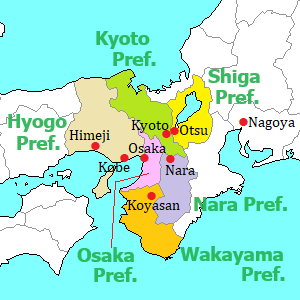
Kyoto and Nara were the ancient capital cities, and Osaka was the commercial center in the area.
Therefore, there were minor forts, but there was no major castle in these cities.
On the way to complete the unification of Japan, the samurai heroes constructed major castles for their government.
On the other hand, many castles had been built on the route to the capital in the surrounding area.
Osaka Castle (大阪城, Osaka Pref.) is a historical great and popular castle built in 1585.
It was constructed by Toyotomi Hideyoshi who was a capable retainer of Oda Nobunaga, then he completed to unite Japan in 1590 instead of assassinated Nobunaga.
The castle tower was burnt down in 1665 and rebuilt in 1931.
Nijo Castle (二条城, Kyoto Pref.) was built in Kyoto city by Tokugawa Ieyasu in 1601.
Kyoto had been the capital where the emperor was living, and this castle was Kyoto branch-office of Edo Castle.
After samurai period, it was changed to a villa of Emperor's family in 1885.
Wakayama Castle (和歌山城, Wakayama Pref.) was built by Toyotomi Hideyoshi in 1585, and it is in the center of Wakayama city.
From 1619, it was one of the castles that Shogun family lived.
Himeji Castle (姫路城, Hyogo Pref.) is the most beautiful and popular castle and it is in Himeji city.
The dazzling white walls are attractive.
It was built in 1580 and is the existing castle tower.
It is designated National Treasure, and it is designated World Heritage Site.
To defend against enemies, the castle site around the castle tower has a complex structure.
Takeda Castle (竹田城, Hyogo Pref.) is a ruin of castle on a hill in the mountainous area in Hyogo Prefecture.
The castle tower had been demolished in the 1600s, so the stone walls remain.
Because a sea of clouds emerges in late autumn, it is also called "Castle in the Sky".
Hikone Castle (彦根城, Shiga Pref.) is near Lake Biwa in Hikine city, and the castle was built in 1622.
The existing castle tower remain, and it is designated National Treasure.
The mascot "Hikonyan" is very popular.
Chugoku Region
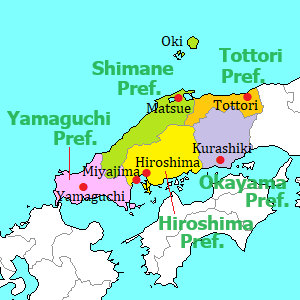
Chugoku Region was the main area to the west of the capital Kyoto.
Some strong warlords were dotted in whole area.
The relatively large castles were constructed in main cities, and developed castle towns were formed.
Okayama Castle (岡山城, Okayama Pref.) was built in the 14th century, and was renovated in the 1590s.
It has a unique black castle tower, so the nickname is "Crow Castle".
The outstanding garden "Korakuen" near the castle was constructed by the lord of the castle.
Bitchu-Matsuyama Castle (備中松山城, Okayama Pref.) is on a mountain near Takahashi city in the center of Okayama Prefecture.
The original castle built around 1683 remain, so it ts designated as important cultural property.
It is also popular as the castle on the sea of clouds.
Hiroshima Castle (広島城, Hiroshima Pref.) was built in 1589.
The great castle was also called "Carp Castle" as the nickname, and it had been designated National Treasure.
The great castle was destroyed by the A-bomb in 1945.
Current castle tower was rebuilt in 1958.
Iwakuni Castle (岩国城, Yamaguchi Pref.) is on the top of a mountain, and there is famous "Kintai Bridge" at the foot of the mountain.
The castle was built in 1608, but was demolished in 1615.
Current castle tower was restored on the basis of the picture in those days in 1962.
Matsue Castle (松江城, Shimane Pref.) is in Matsue city and near Lake Shinji.
It has the existing castle tower built in 1611 and is designated National Treasure.
The moats surrounding the castle are also attractive.
Shikoku Region

Shikoku Island is relatively close to Osaka and Kyoto in the center of ancient Japan.
And Seto Inland Sea on the north side of Shikoku is an important route of water transportation.
So several castles were built to manage this island.
Fortunatly, in Shikoku, there are 4 exiting castles of 12 ones in Japan
Takamatsu Castle (高松城, Kagawa Pref.) is by Takamatsu Port.
It was built in 1587, but the castle tower was demolished in 1884.
The moats of this castle are connected to the sea, so they are still filled with seawater.
Marugame Castle (丸亀城, Kagawa Pref.) is in Marugame city to the west of Takamatsu city.
It was built in 1602, and it has the existing castle tower built in 1660.
The stone walls are the highest in Japan.
Kochi Castle (高知城, Kochi Pref.) is in Kochi city on the south side of Shikoku.
It was built in 1603, but was rebuilt in 1753 after being burnt down in 1727.
The castle tower and some buildings are perfectly original, so they are very valuable.
Matsuyama Castle (松山城, Ehime Pref.) is located on a hill in the center of the city.
The castle was constructed in 1602 and the castle tower was built in 1642.
After destruction by fire, current castle tower was rebuilt in 1854.
It is one of the existing castle towers in Japan.
Ozu Castle (大洲城, Ehime Pref.) is in Ozu city in the valley formed by a river and and the castle town has the historic atmosphere.
The castle tower was restored in 2004, and the castle tower can accommodate a guest as the samurai lord for the night.
Uwajima Castle (宇和島城, Ehime Pref.) is in Uwajima city in the southwestern part of Shikoku.
The castle was built as fort in 941, and it was renoveted in 1601.
The original castle tower still remain.
Kyushu Region
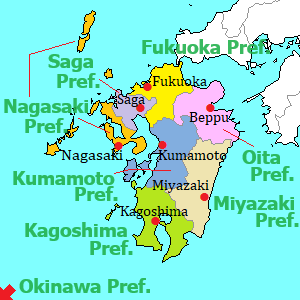
Kyushu Island is close to Korean Peninsula, so battles took place several times since ancient times.
Ancient Japan participated in the war for a small country in Korea in the 7th century.
The mongolian army attacked to Kyushu twice in the 13th century.
Toyotomi Hideyoshi who united Japan sent the army to occupy China from Kyushu in the 1590s.
So, a lot of castles and fortresses had been constructed in Kyushu.
But many of them are ruins.
Kokura Castle (小倉城, Fukuoka Pref.) is in Kitakyushu city.
The castle was built in 1602, but it was destroyed by civil war in 1866.
It was restored based on original design in 1959, but additional roofs and decorations were added to look more gorgeous by request of the citizens.
Shimabara Castle (島原城, Nagasaki Pref.) is in Shimabara city and was built in 1624.
The lord was a tyrant, so the citizens rose in revolt against him in 1637.
The rebellion became the greatest civil war in the history of Japan.
Hirado Castle (平戸城, Nagasaki Pref.) was built in 1707 and was restored in 1962.
Hirado was the city where Christianity was propagated to the people for the first time in Japan, so we can see the castle, Christian churches and Buddhist temples in the old city.
Kumamoto Castle (熊本城, Kumamoto Pref.) is called as one of the great castles along with Nagoya Castle, Osaka Castle.
The castle was built in 1607, and the castle tower was rebuilt in 1960.
But, it was badly damaged in the great earthquake in 2016.
Kitsuki Castle (杵築城, Oita Pref.) is by the sea in Kitsuki city.
The castle was built in 1394, but it is unclear when the original castle tower was built.
Current castle tower was built as the museum in 1970, and it is called the smallest castle tower in Japan.
Okinawa was originally Ryukyu Kingdom founded in 1429.
Japan annexed Ryukyu in 1879, then it became Okinawa Prefecture.
In the history of Ryukyu, some castles had been built in Okinawa Island.
Because the culture is different from Japan, the type of the castle is simmilar to China.
Shuri Castle (首里城, Naha city) is the castle of former Ryukyu Kingdom around the 14th century, and it is still the symbol of Okinawa.
Unfortunately, the main castle was burnt down in 2019.
But it is under restoration now.

